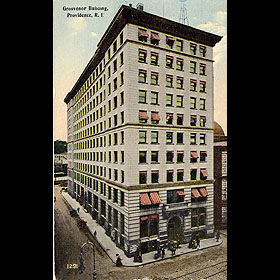
Introduction
At the turn of the century, tall office buildings became the symbol of American urbanity and modernity. Although decidedly horizontal in layout due to its elongated footprint, the Banigan building was considered Providence’s first skyscraper, a ten-story steel-frame, granite-covered building at the bottom of College St., surrounded by modern glass high-rises and other historic monuments. Notably, it was Providence’s first fire-proof, steel-frame building of its height. Joseph Banigan was the child of working Irish immigrants, an unlikely business success for the time. He founded the U.S Rubber Company, then sold out and ventured into real estate investment, beginning with the building named for him. Norcross Brothers were one of the foremost builders in the country, whose works included the Trinity Church in Boston, and the Rhode Island State House.
Description
Built on a trapezoidal lot, the Banigan building is heavy and formal, with height and thickness. The two bottom stories are covered in rusticated granite, and on the top eight floors the building is smooth. String coursing runs above the second, fifth and ninth floors, and the flat roof is bordered by a huge copper cornice. The back façade is kept in cheaper brick cladding. The exterior of the Banigan building is classic and modern in its simplicity. Unlike the grandiose facades of many buildings of the nineteenth century, the Banigan building displays its intent to represent, as Providence’s first “skyscraper,” modernity, advancement, and the city.
Today
Since the acquisition of the Banigan building (or Grosvenor building as it later became) by AMICA, a Providence-based insurance company after whom the building is now named, the interior of the building has undergone massive rehabilitation. The first half of the 1980s was spent modernizing utilities, adding air conditioning, and painting the newly exposed southwest wall to match the taupe color of the building’s stone. The building now remains a bridge between the ornament and weighty stone of the nineteenth century and the slick glass skins of the more modern high-rises. It has been outbuilt, both in size and in style many times before and after it was erected, and it is not a building most would admire for long, compared to the Hospital Trust and other buildings around it. But the Banigan building is important, both for the obvious quality of its construction and for its role in imagining the city at the turn of the century, as the first building of its type in Providence.
Sources
Wm. McKenzie Woodward, Edward F. Sanderson Providence: A citywide survey of historic resources (Providence, RI: Rhode Island Historical Preservation Commission, 1986): 242;
John Hutchins Cady, The Civic and Architectural Development of Providence 1636-1950 (Providence: The Book Shop, 1957): 189












